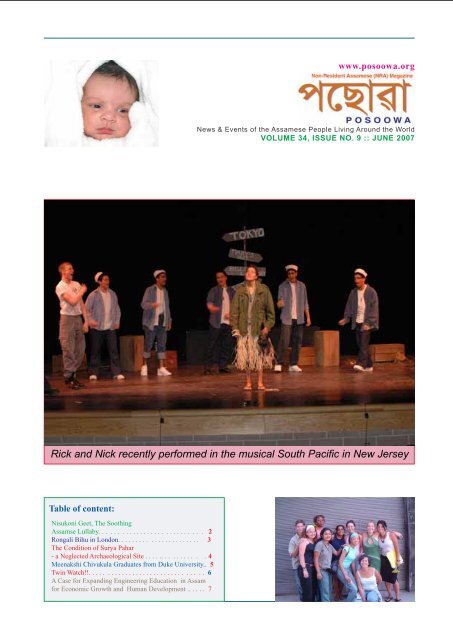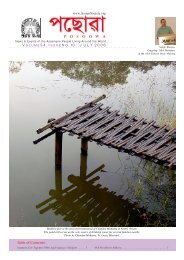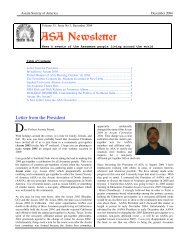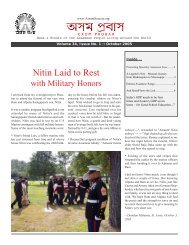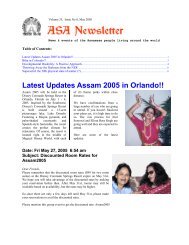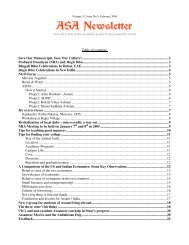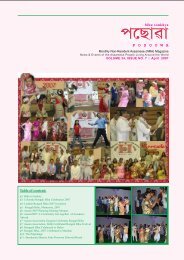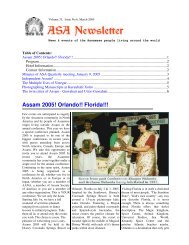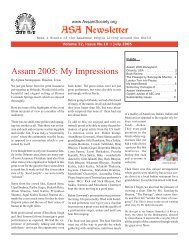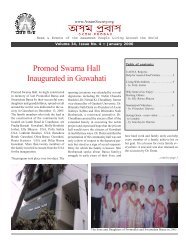June 2007 - Assam.Org
June 2007 - Assam.Org
June 2007 - Assam.Org
You also want an ePaper? Increase the reach of your titles
YUMPU automatically turns print PDFs into web optimized ePapers that Google loves.
Rongali Bihuin LondonLondon’s recent annualRongali Bihu saw a recordnumber of attendants with themajority of new comers fromthe younger generation.Almost 200 adults and scores of childrenfrom across the United Kingdomdescended on North London to celebratethe <strong>Assam</strong>ese new year.Guests of the London Bihu commitee,which organised the event, were greetedwith jalpan, such as siradoy, pitah andlaroo, as they arrived at the St AndrewsChurch Hall, where artists from Britainand India held a cultural festival.Dr Jiten Borkakoti, the president of theLondon committee, used his welcomingspeech to call for the younger generationto use Bihu as an opportunity to learnabout <strong>Assam</strong>ese culture and to get toknow their fellow brethren.“We, as the first generation in the UK,are now getting old and want to knowthat when we are gone our children andnew <strong>Assam</strong>ese that have come to thecountry are there to support each other,”explained Dr Borkakoti. “That’s why wewould urge you to start using Bihu as achance to network with follow<strong>Assam</strong>ese in your generation and tolearn about your heritage.”The latter was already taking place withyoung girl Anya Das exhibiting hertalents as an Indian dancer and teenagerReema Kakati performing the Kathak.The young local talent was counterbalancedwith the enchanting classicalvoice of <strong>Assam</strong>ese guest artist MandiraLahiri, from Kolkata, who wasaccompanied by tablist Rajkumar Misra.The informal and relaxed atmosphereset the right conditions for the youngergeneration to mingle, leading to sometaking their newly formed friendshipsto local pub The Wishing Well to cementtheir relationships away from the pryingeyes of their parents.But as the evening turned to night, theabsconded young adults were back forBihu Bhoj, a typical <strong>Assam</strong>ese feast,followed by a general Bihu dance towork off those calories.Again the increased inclusion of theyounger generation was clear, withmany on the dancefloor with theirelders.As the dancing continued, one youngadult, who wished not to be named, said:“This Bihu and similar <strong>Assam</strong>ese eventshave been key in ensuring that we, assecond generation <strong>Assam</strong>ese, stay intouch and remember our roots.”“The message to us is clear, with so few<strong>Assam</strong>ese in the UK, all from themotherland are a family within the UKand so we should always be there foreach other.”By Nina Goswami, a second generation<strong>Assam</strong>ese in London. Nina is a lawyerand a former Sunday Telegraph andSunday Times journalist, now a reporterfor a legal magazine here in London.The piece is about London Bihu whichtook place in May 6 th <strong>2007</strong>|By Nina GoswamiDulari Tahbildar, daughter of Umesh C. & Pronoti Tahbildarof West Windsor, NJ graduated with Master of City Planningdegree from the Massachusetts Institute of Technology(MIT) on <strong>June</strong> 8, <strong>2007</strong> . As a part of the requirements for thedegree, Dulari wrote a thesis on a Case Study of Civic engagementand Planning “from below” to promote EducationalEquity in Post-Katrina New Orleans. Dulari currently lives inSomerville, MA where her husband, Keith Catone is finishinghis Ph.D at Harvard Graduate School of Education.Dr. Namrata Gargee Choudhury, daughter of Niren andShakuntala Choudhury of Bridgewater, NJ recently receivedher M.D. degree from New York Medical College, Valhalla,NY. She received her Bio-Engineering degree from theUniversity of Pennsylvania in 2003. Among her manyhonors, she was the 1st Prize Wnner of the MedicalStrudent's Clinical Vignette Award presented by theAmerican College of Physicians. During April, <strong>2007</strong>, shecompleted her internship at Sankar Netralaya, Guwahati - apremier eye hospital of North-eastern India. Namrata juststarted her residency at Northwestern University's Children'sMemorial Hospital in Chicago, IL.Page 3 * POSOOWA, <strong>June</strong> <strong>2007</strong>
Twin Watch!!Rupak Kumar Bhuyan of New Jersey,popularly known as Rick, isa talented sixteen year old artist.He is a sophomore (i.e., a highschool student of Class Ten). Rick has devotedmuch time to the performing arts. Heis an accomplished actor and singer.At age nine, Rick made the debut performanceof his singing career at Y2K <strong>Assam</strong> Conferenceat the Cherry Hill Hilton, in NJ. Sincethen, he has sung all across America. Thereare scarcely any opportunities to sing<strong>Assam</strong>ese songs in America. So more than 95% of Rick’s performances are confined toEnglish. In addition, Rick’s acting performances are solely in English and fully confined toAmerican functions.Up to date, Rick and his twin brother Nick have recorded forty songs in five differentalbums. Of these five albums, three are in <strong>Assam</strong>ese; one is in English; and the last is inHindi.At the age of thirteen, Rick and his twin brother Nick were inducted into the South JerseyChorus, representing eight counties. Since then, both have been continuously singing forthis chorus.In 2005, CN8 (a cable TV show in tri-state area of Pennsylvania, Delaware and New Jersey)had broadcast a 15-minute segment on Rick. Besides that, Rick and Nick both appearedon the NBC Christmas Choral in the Atlantic City Area of New Jersey in 2004.Recently, Rick was selected to sing in the <strong>2007</strong> All State Chorus in New Jersey, representingState of New Jersey. This is a great achievement for any young aspiring artistand we wish him all the best.By Ganesh Bora, Lake Alfred, FloridaTo sample their singing (Rongali Bihu in New Jersey, <strong>2007</strong>)1. Hussori - Bihu - <strong>Assam</strong>ese:http://www.youtube.com/watch?v=mfAy-BXpyDM2. Bihu Geet, <strong>Assam</strong>ese:http://www.youtube.com/watch?v=yGCddjKS9e43. Adhunik Geet, <strong>Assam</strong>ese:http://www.youtube.com/watch?v=APcde9IXM1UUmesh Tahbhildar of NewJersey was inducted a lifemember of the AmericanSociety of Civil Engineers forhis life long dedication andservice to the profession ofcivil engineering.Page 6 * POSOOWA, <strong>June</strong> <strong>2007</strong>
Jorhat Engineering College, Jorhat. Photo by: Mr. Ranjit Kumar Dutta, Mechanical Engineer,1981 batch. Source: http://www.angelfire.com/ne/jec/2001, the number of engineering collegeswent up to 82. 9 By <strong>2007</strong>, the number ofengineering colleges has gone up to 123. 10These do not include institutes that do notwith 439689 entering students. 13 In 2004,<strong>Assam</strong> had an estimated population of 27.9million out of India’s estimated populationof 1079.1 million during the same year. 14 In2004, <strong>Assam</strong> had 3 engineering collegeswith 750 entering students. 15 Thus, in 2004,<strong>Assam</strong> had 2.589% of India’s population,0.222% of engineering colleges in India, and0.171% of entering engineering students inIndia.5. Engineering Colleges in High PercapitaStatesand the number of entering studentsper year as of 2004 for someselected states is given below. 16 Inaddition, there are 105 positionsavailable in engineering colleges indifferent parts of India for residentsof <strong>Assam</strong> on a quota system. 17Though it is very difficult toestimate how many students havemigrated to other states from<strong>Assam</strong> for their engineeringeducation, an article in the <strong>Assam</strong>Tribune, April 13, <strong>2007</strong> stated thatstudents from <strong>Assam</strong> who go toother states for educationalpurposes spend INR1800 millionrupees every year. 18 The populations of thestates mentioned above are given below. 19<strong>Assam</strong>’s population is projected to grow to30.2 million by 2010, 33.9 million by 2020and 35.6 million by 2026. 206. How many engineering colleges areneeded in <strong>Assam</strong>?If we look at the table above, we see thatthe number of entering engineering studentsin <strong>Assam</strong> is the smallest compared to thehave approval of the All IndiaCouncil of Technical Education (AICTE).Tamil Nadu has 350 engineering colleges.11This is the highest in India. Maharashtrahad 115 engineering colleges as of 2005. 12In 2004, India had 1346 engineering collegesCompared to almost every state in India witha substantial population, <strong>Assam</strong> has asurprisingly small number of engineeringcolleges. When one performs research,sometimes it is confusing to know exactlyhow many are private engineering collegesand how many are government supported.The best way to get to a core set of numbersis to obtain the list of engineering collegespublished by AICTE. AICTE is a statutorybody, established in 1945 for the properplanning and development of a technicaleducation system in India. The number ofengineering colleges approved by AICTEA Poem..-- Rubul Mout, Tata Institute ofFundamental Research(TIFR),MumbaiPage 8 * POSOOWA, <strong>June</strong> <strong>2007</strong>
ten states we have chosen to compare with.West Bengal comes closest, but even it has6.9 times the number of entering studentscompared to <strong>Assam</strong>. The South Indian statesof Andhra Pradesh, Karnataka, Kerala andTamil Nadu have the highest number ofentering students per million, 38.9, 31.3,27.4 and 46 times that of <strong>Assam</strong> per millionpeople, respectively. These are among themost advanced in high-technology fieldscompared to any other states in India. <strong>Assam</strong>can try to follow the lead of these four states.These four states have a population of 223.3million and a total engineering enteringpopulation of 234,175. This gives 1049entering students per million population.<strong>Assam</strong> has a population of 26.5 million. If<strong>Assam</strong> is to have 1049 entering engineeringstudents per million population, <strong>Assam</strong>should have 27,799 entering engineeringstudents. <strong>Assam</strong> now has only 750 enteringengineering students. <strong>Assam</strong> needs another27,799 – 750 = 27,749 entering engineeringstudents. Currently, <strong>Assam</strong>’s engineeringcolleges have approximately 250 enteringstudents each. If <strong>Assam</strong> wants to start anumber of engineering colleges to make upfor the short fall, <strong>Assam</strong> will need 111engineering colleges immediately. Ofcourse, that’s not possible due to expensesand other issues such as recruitment of highqualityfaculty and adequate employmentopportunities for graduating engineers. So,what <strong>Assam</strong> can plan to do immediately, istry to go up to the level of 10-15% of thesestates. Even that will need <strong>Assam</strong> to open11~16 new engineering colleges. Since onecollege has already been announced, <strong>Assam</strong>is well-advised to open 10 new engineeringcolleges.7. Where should the engineering collegesbe situated?Karnataka decided to start six new stateengineering colleges in <strong>2007</strong>. 21 Four of theseare polytechnic institutes upgraded toengineering colleges because it is lessexpensive that starting new engineeringcolleges from scratch. <strong>Assam</strong> has 9polytechnic institutes: 22 <strong>Assam</strong> EngineeringInstitute (AEI, Guwahati), <strong>Assam</strong> TextileInstitute (Guwahati), BongaigaonPolytechnic, Dibrugarh Polytechnic, IndianInstitute of Handloom Technology(Guwahati), Nagaon Polytechnic, SilcharPolytechnic, and Diphu Polytechnic. Ofthese, the AEI, and the Polytechnic Institutesin Bongaigaon, Dibrugarh, Nagaon andDiphu should be converted to full-fledgedengineering colleges immediately. 23 Theothers are specialized institutions and shouldbe left as such. However, we propose that athird engineering college be established inGuwahati in addition to <strong>Assam</strong> EngineeringCollege and the upgraded <strong>Assam</strong>Engineering Institute. One of the remainingPolytechnic Institutes in Guwahati beconverted to an engineering college as well.This is because Guwahati is the economicand educational hub of <strong>Assam</strong>, which iseasily reachable from all over <strong>Assam</strong>. Thisupgrade will give us 5 more engineeringcolleges bringing up to 9 engineeringcolleges. These new engineering collegeswill give a good geographic distribution tothe engineering colleges. To further providefor geographically equitable distribution, anengineering college should be started in eachof the following 6 places: Dhemaji,Lakhimpur, Mangaldoi, Nalbari, Dhubri andHailakandi as well, bring to a total of 15engineering colleges. <strong>Assam</strong> has 28Industrial Training Institutes (ITI). Of these2 were selected for upgrading by the FinanceMinistry of the Government of India in2004-05 24 when it proposed upgrading 100out of 500 ITIs in India. An initial idea willbe to house the new engineering colleges atthe ITIs in these or nearby locations. Forexample, in the case of Mangaldoi District,there is an ITI in Majbat and another one inUdalguri, not in Mangaldoi Town.Some of the proposed engineering collegescan be in the private sector and involvementof the private sector should be encouragedwherever possible. A recent article estimatesthat a private engineering college started in<strong>Assam</strong> can break even in seven years andstart making profits thereafter. 25 A quickperusal of the list of universities and collegesin India shows many private universities andengineering colleges in many states. 26 Evenstates such as Himachal Pradesh areencouraging the concept of privateuniversities to upgrade higher educationalinfrastructure. 27A deeper understanding of the reasons whya considerable number of students leave<strong>Assam</strong> to pursue education in engineeringoutside <strong>Assam</strong> should be considered inselecting locations for the new engineeringcolleges. Besides the obvious reason that<strong>Assam</strong> lacks engineering colleges, otherreasons include the lack of a conduciveacademic atmosphere, better facilities, andthe opportunity to pursue engineeringcareers in one’s own state. Many engineeringcolleges outside <strong>Assam</strong> are located far awayfrom big urban locations. People are wellaware of the number of college days lost in<strong>Assam</strong> due to strike and other activities.Invariably, students in colleges situated inurban neighborhood participate in thesestrikes and as a result there is lots of fiscaldays are lost in the colleges. Thus, it maybe advisable to situate many of the newengineering colleges in rural locations justoutside towns so that the effect of strikes isless devastating. In addition, facilitiesprovided, such as library resources and thereliability of Internet computer connectionsshould be of high quality to begin with sothat these colleges can function even whenthere are strikes and other problems in thetowns. Thus, in the long run, the campusesof these engineering colleges should be selfcontainedas much as possible. In fact, it maybe an excellent idea to provide for powergeneration using windmills and solar panelsfor the engineering colleges so that theydon’t suffer from rampant power shortagein <strong>Assam</strong>. Indian companies are quietlybecome global leaders in selling windturbine towers 28 and these companies shouldbe consulted right from the beginning.Establishing the proposed new engineeringcolleges in rural districts and areas willdistribute the economic growth and humandevelopment and provide infrastructure forcommunication (physical and electronic).8. BudgetWe need to take into consideration Cost ofbuilding 7 new engineering colleges,upgrading 5 Polytechnic Institutes, andupgrading the existing 3 engineeringPage 9 * POSOOWA, <strong>June</strong> <strong>2007</strong>
colleges. We also need to consider cost ofpersonnel.Building 7 new engineering colleges +upgrading 5 Polytechnic Institutes:Let us assume that we will start eachengineering college with 4 departments, oneof which is going to be Computer andInformation Sciences. The other threedepartments will be chosen based on theregion’s needs. One of the remaining threecan be geared towards business andentrepreneurial education.Let us assume that for a good engineeringcollege to be established we need a buildingof 75,000 square feet for each departmentfor class room buildings, laboratories,auxiliary services, etc. This gives us a totalof 300,000 square feet for the academicdepartments. Let us add a 50,000 square feetof space for administration. Assume we alsoneed 100,000 square feet space fordormitories. Assume that to start with noliving quarters are provided for the facultyand staff; they are supposed to rent livingspace outside campus. The estimated persquare-foot cost is INR 1000. Therefore, forthe construction of 450,000 square feet ofspace, we need INR 450,000 * 1000 = INR450 million. So, the construction cost fromscratch is INR 450 million per college.Assume for those colleges that are going tobe upgrades of existing PolytechnicInstitutes, the cost is 60% of this amount.Therefore, the total cost = Cost of a newcollege in Goalpara (already announced) +Cost of upgrading 5 Polytechnic Institutes+ Cost of 6 new proposed engineeringcolleges = 450 + 225 * 5 + 450 * 6 = INR4275 million. Let us add 50% to this cost totake care of inflation, cost overruns, thingsnot considered in detail in this preliminaryproposal. This brings the total to INR 4275* 1.5 = INR 6412.5 million.Assume we need 10% of the amount foryearly maintenance. So, the yearly buildingmaintenance budget is INR 6412.5 * .1 =INR 641.3 million.Initial Computers, Laboratory and otherResources: Let us assume that theequipment and other resources in eachcollege is going to need an initialexpenditure of INR 10 million each for thenewly established colleges, and 60% of thisamount for the upgraded colleges. This givesus a total of 7 * 10 + 5 * 6 = INR 100 million.Let us also assume that there will be a needof 10% of this amount yearly formaintenance, upgrade, etc. This yearlycommitment is INR 10 million.administrators, INR 10,000 a month salaryon an average for staff members, and INR40,000 a month salary on an average forfaculty members. This gives us a total of(60,000 *5 + 10,000 * 15 + 40,000 * 40) *12 = 24,600,000 or INR 24.6 million peryear in salaries. Let us add 20% overheadon this amount for other expenses associatedwith the employees. This gives us a total ofINR 28.8 million per year for employeeexpenses.<strong>Assam</strong> Budget: The <strong>2007</strong>-08 budget for<strong>Assam</strong> estimated revenue of INR 727,346million and expenditure of INR 731,010million with a deficit of INR 28,362million. 29 For <strong>Assam</strong> to prosper, a focus onengineering and higher education isextremely timely and important. <strong>Assam</strong> canfind approximately INR 7,000 million tostart the engineering colleges as proposedin this document. 30 Establishing theengineering colleges proposed in this essayis clearly feasible considering the financialresources of <strong>Assam</strong> Government. TheGovernment of <strong>Assam</strong> should explore grantsfrom the Union Government to meet part ofthe initial expenditures. In addition, publicprivatecollaborations should be activelypursued. For example, the governmentshould allow private educational trusts toestablish engineering colleges in the new orupgraded sites and provide them withinfrastructure support such as availability ofland and communication. Private investmentin engineering colleges is more like in a citylike Guwahati; such investments should beactively pursued.9. AdministrationKarnataka created VisveswaraiahTechnological University (VTU) inBelgaum in 1998 to oversee all engineering,MBA and related program in Karnataka. 31There is a common entrance examination forall engineering programs within theuniversity. All colleges within Karnatakamust have approval from VTU to offerengineering programs. <strong>Assam</strong> can follow thelead of Karnataka and organize all theengineering colleges to a technicaluniversity, headquartered in Nagaon, acentral location which in not Guwahati.Nagaon is easily reachable from all of<strong>Assam</strong>—Upper, Lower, Karbi Anglong,Barak Valley, etc. It is easily reachable fromArunachal, Manipur, Nagaland, and otherNorth-Eastern states of India as well. Analternative site is Mangaldoi, although alittle difficult to reach in terms of roadtransportation. We note that thetechnological university in Karnataka isheadquartered in Belgaum in thenorthwestern part of the state instead ofBangalore or Mysore.Considering the current academic health andfinancial situations of Gauhati Universityand Dibrugarh University, and the fact thatTezpur University and <strong>Assam</strong> Universitiesare unitary in nature by law, the concept ofstarting a technological university mannedmostly by technical individuals of highcaliber to administer the new engineeringcolleges instead of a Directorate is highlyrecommended.10. Recruitment of StudentsThe number of entering students in each ofthe new engineering colleges can be cappedat 100 to begin with. <strong>Assam</strong> already has 750entering students in the 3 existingengineering colleges. If the 12 newengineering colleges accept 1200 morestudents per year, the total number ofentering students will go up 1950 per year.Where will these students come from? Thereare several sources:1. Students graduating in the HSSLCExaminations in the ScienceStream in <strong>Assam</strong>,2. Students graduating in non-Science Streams in the HSSLCExaminations in <strong>Assam</strong>,Personnel: Assume per engineering college,we need 5 administrators, 15 staff membersand 40 faculty members. Assume INR60,000 a month salary on an average forPage 10 * POSOOWA, <strong>June</strong> <strong>2007</strong>IIT Guwahati
that the best individuals are attracted.Advertisements should be placed in all-Indiaand international engineering periodicals.Recruitment should be based on merit.<strong>Assam</strong> should be able to recruit 400 to 500engineering professors needed over a periodof several years. Many of the engineeringprofessors working outside <strong>Assam</strong> or abroadwill be encouraged to establish partnershipswith the <strong>Assam</strong> engineering colleges. Theaccomplished faculty will be encouraged totake sabbatical leave from their homeinstitutions and spend time at these collegesto provide leadership and help buildprograms at a minimum cost.12. Curriculum DevelopmentAICTE is the body that approvesengineering programs in India. The newinstitutions have to be approved by AICTE.The institutions can also get accreditationfrom the National Board for Accreditation(NBA) although it is not necessary. In fact,<strong>Assam</strong> has no accredited engineering collegeas of May, 2006. 38 <strong>Assam</strong> should require allinstitutions to obtain NBAaccreditation within, say10 years ofestablishment. In fact,the NBA has haddiscussions with theInstitution for Electricaland ElectronicEngineers (IEEE)regarding accreditationissues lately. 39 In theUS, Engineeringundergraduate programs are accredited byABET 40 after an elaborate process. It willbe advised to ask the engineering collegesin <strong>Assam</strong> to align their curricula as much aspossible with ABET’s requirementsalthough it is not essential to do so. Nonresident<strong>Assam</strong>ese (NRA) in the USA whoare in engineering teaching and research canassist in developing such curricula. It shouldbe of paramount importance to developprograms, which have the potential tobecome national leaders. Some of the Non-Resident <strong>Assam</strong>ese engineering educatorsare already well-linked with other Indianinstitutions and the Government of India inbuilding partnerships. For example, Dr.Prasanta Kalita of the University of Illinoisconsults with the Prime Minister of India’sOffice on engineering education. They willbe happy to connect and build partnershipswith engineering colleges in <strong>Assam</strong>.13. Impact on Local Economies and<strong>Assam</strong>’s EconomyAlmost every engineer in <strong>Assam</strong> of anystripe is from one of <strong>Assam</strong> EngineeringCollege, Jorhat Engineering College or theNational Technical Institute, Silchar.<strong>Assam</strong>ese IIT graduates are a rare breed.There are a substantial number of RegionalEngineering College (now, NationalInstitutes of Technology) graduates from<strong>Assam</strong>, and some from private engineeringcolleges such as Birla Institutes ofTechnology. Engineers from the three localengineering colleges have had tremendousimpact on <strong>Assam</strong>. These three colleges havethousands of alumni all over the worldincluding Bangalore, Hyderabad, Delhi,Pune, US, Canada, Australia and the MiddleEast. The establishment of 11 newengineering colleges in <strong>Assam</strong> (over say, 5or 10 years) will change the perception of<strong>Assam</strong> to its people as well people outside.The recent history of <strong>Assam</strong> has made manypeople unsure of its future although thingsare starting to change for the better. Theestablishment of these engineering collegesin <strong>Assam</strong> will signal that <strong>Assam</strong> wants to bea player in the emerging globalized hi-techeconomy. Each engineering college willprovide a boost to the economy of the localregion. The salaries of the professors, staffmembers and administrators, and the moneyspent by the students will play an upliftingrole, especially in the smaller towns. TheTezpur Universitystudents and the professors will provide rolemodels to others, especially in the ruralareas. Many of the students will leave townafter graduation, migrate to South India orDelhi or abroad. This brain drain is not allthat bad. These people will advance throughtheir careers and will send back money to<strong>Assam</strong> to their families. Many will comeback at a certain point in time to work in<strong>Assam</strong>. Either way, <strong>Assam</strong> will benefit inthe long run. These colleges will teachconcepts of business, innovation andentrepreneurship as well as engineering.Thus, some of these students will be primedto start enterprises in <strong>Assam</strong>. As cities likeBangalore, Pune and Hyderabad becomeexpensive, development in high-tech andother engineering fields will move to smallercities and towns. In fact, the Government ofIndia is actively supporting the developmentof a number of second-tier cities.Information Technology jobs andoutsourced jobs are going to start movinginto these cities in the near future. Theestablishment of these engineering collegeswill get <strong>Assam</strong> ready for this day that willarrive soon. Although it is difficult to predicthow the establishment of the newengineering colleges will impact on <strong>Assam</strong>’sper-capita income in a direct manner, it is awell-established fact that highly educatedPage 12 * POSOOWA, <strong>June</strong> <strong>2007</strong>societies are able to harness human talentand that they have higher per-capita incomesand quality of life.Developing a relationship with alumnishould be a focus of the engineering collegesfrom the very beginning. Keepingconnections with alumni, organizing“Homecoming” events, inviting successfulalumni to give presentations, andencouraging highly placed alumni to recruitstudents should be given priority. A longtermconnection with alumni is also likelyto bring in dividends in terms of money andnon-monetary contributions. Alumnirelations are not a strong point of mostuniversities and colleges in <strong>Assam</strong> at thistime.If additional engineering colleges areestablished in <strong>Assam</strong>, will it lead to growthof software and other high-technologyindustries in <strong>Assam</strong>? The answer is mostcertainly in the affirmative. A recent articleexplains why Infosys, a leading hightechnologycompany in Indiaand the world, hasa 12,000 employees t r o n gdevelopmentcenter inBhubaneswar,Orissa and not inGuwahati, <strong>Assam</strong>a l t h o u g hGuwahati hasbetter air-connectivity, better hotels andother facilities. 41 According to this article,Infosys has several pre-conditions beforestarting development centers in a location,the primary being manpower ability. Orissahad 41 engineering colleges in 2004 with13,000 entering students annually. As aresult, 80% of the employees in the InfosysOrissa development center are from Orissa.According to Infosys chairman, as quotedin this article, if a software developmentcenter is started in Guwahati, employeeshave to be hired from outside <strong>Assam</strong> and itis not cost-effective to do so. The conclusionof the article is that software developmentis manpower intensive and corporations willset up centers where manpower is locallyavailable. By interpolating from theconclusions of this article, it is possible tosurmise that if the new engineering collegesin <strong>Assam</strong> produce a thousand or more newgraduates, it is possible that corporationswill come to <strong>Assam</strong> to recruit them and keepthem in <strong>Assam</strong>.14. How can NRAs Help?Non-resident <strong>Assam</strong>ese individuals in otherparts of India as well abroad should beencouraged to help in the development ofcurricula for these engineering colleges.Many such individuals can act as volunteers
or consultants. Non-resident <strong>Assam</strong>ese arehighly educated individuals. They maketrips back to <strong>Assam</strong> on a regular basis. Theyshould be tapped to come to theseengineering colleges, give lectures, take partin conferences, etc. The NRA should betapped to provide for jobs when engineeringgraduates go outside <strong>Assam</strong> to find jobs.NRA individuals who have becomesuccessful should be tapped to invest in<strong>Assam</strong> and start engineering or high-techcompanies in <strong>Assam</strong> and employ graduatesof the engineering colleges.15. Should we have Business andEntrepreneurship studies along withEngineering?The new engineering colleges will educatethe students not only in engineering, but alsoin business, entrepreneurship, globalizationand innovation. The curricula could bemodeled after the Bachelor of Innovation setof degrees recently started at the Universityof Colorado. 42National Institute of Technology, SilcharNational Institute of Technology SilcharIn addition, professional and technologicalcourses along with short-term certificateprograms can boost the idea of selfsupportingthe institute.16. Comparison with India and theWorld: Challenges for <strong>Assam</strong>According to the AICTE, approximately440,000 students were enrolled at Bachelorsdegree engineering programs in 2004-05 inIndia, 265,000 at the diploma level and33,000 at the Master’s level. The seven IITshad a total of 25,000 students enrolled at alllevels in 2002-03. 43 A study by researchersfrom Duke University estimates the numberof engineering Bachelors graduates at112,000 including Computer Science andrelated fields, but notes that almost half aregraduating from three-year diplomaprograms. 44 45 The Duke authors estimatethat U.S. institutions graduate 137,437engineering students annually. In China, thatnumber is close to 640,000, of whichapproximately 350,000 graduate frombachelor programs and 290,000 from shortcycleassociate-equivalent programs. In2002-03, the seven IITs together graduated2,275 B.Techs, 3,675 M.Techs and 445Ph.D.s, with 11,700 undergraduates (fouryearprogram), 9,500 graduate students and3,800 doctoral students. Taking the Dukeestimate of 215,000 first-level engineeringgraduates, IIT bachelor of technologygraduates represent just 1 percent of the totalgraduating class of Indian engineers eachyear. After the IITs, there are the NationalInstitutes of Technology. These were calledRegional Engineering Colleges earlier. Thestate-level engineering colleges are the thirdtierinstitutions. The plea in this essay is tohave a sufficient number of engineeringcolleges and entering positions in the stateof <strong>Assam</strong>. The second plea is to fund thestate-level institutions and develop theinfrastructure in such a manner that theseinstitutes are of excellent quality, at par orabove the National Institutes of Technology.Prepared by:Dr. Jugal Kalita: Dr.Jugal Kalita went toprimary school in NatunBazar Nimno BuniyadiSchool in Nagaon. Hishigh school educationwas in Nagaon Government BoysSchool, Nagaon, and RamakrishnaMissionVidyapith, Deoghar, Bihar. Hewas a member of the first graduatingComputer Science and EngineeringB.Tech. class in India in IIT, Kharagpurin 1982. Subsquently, he received anMSc in Computational Science from theUniversity of Saskatchewan, Canada;an MS (1988) and a Ph.D. (1990) inComputer and Information Science fromthe University of Pennsylvania.Currently, he is Professor of ComputerScience at the University of Coloradoat Colorado Springs.Dr. Umesh Tahbildar:An aerospace engineer,Dr. Tahbildar currentlyworks on the SpaceShuttle Program forNASA’s Goddard SpaceFlight Center atGreenbelt, Maryland. Born and broughtup in Guwahati, <strong>Assam</strong>, Dr. Tahbildardid his early schooling successively inChenikuthi Primary School, MCMESchool and Cotton College in Guwahati.After completing his B.Tech.(Hons.)degree in Civil Engineering at IIT,Kharagpur he had a brief stint as alecturer in both Jalukbari EngineeringCollege and Jorhat EngineeringCollege. Dr. Tahbildar went to Englandunder a Govt. of <strong>Assam</strong> overseasscholarship where he completed MSdegree in Manchester University andPh. D. degree in SouthamptonUniversity in Structural Engineering.After completing a brief post-doctoralresearch assignment in the SolidMechanics Division of the University ofWaterloo, Canada, Dr. Tahbildarimmigrated to the USA where he haslived and worked ever since workingfirst in the Nuclear Power PlantIndustry and then switching toAerospace industry by dint of hisexpertise in application of StructuralDynamics in design and analysis of anentire gamut of structures includingSpacecraft, Aircraft, Helicopters,Rockets, Space Shuttle and theInternational Space Station. Dr.Tahbildar is married with two grown updaughters. His wife, Pronoti, is also anengineer working for the Department ofTransportation on Roads and Highwaysfor the state of NewJersey.Dr. Ganesh Bora: Dr.Ganesh Bora is anAgricultural EngineerPage 13 * POSOOWA, <strong>June</strong> <strong>2007</strong>
y profession and works with Universityof Florida. He began his primaryeducation in Kampur M.V. School,completed ICSE & ISC from RajkumarCollege, Raipur, Chhattisgarh; finallyreceived his PhD from Kansas StateUniversity, Manhattan, KS. He has beeninvolved in Teaching, Research, andExtension in <strong>Assam</strong>, Thailand and USA.Besides having many technical journalarticles to his credit, he also writes poemand short stories in <strong>Assam</strong>ese andrepresented his university in Hockey anddebate.Dr. Mantu Baishya: Dr.Mantu Baishya went tohigh school in NagaonGovernment BoysSchool. Hisundergraduate collegeeducation was in Nagaon College(Nagaon) and the Birla Institute ofTechnology, Pilani, Rajasthan where hereceived B.Tech. in Civil Engineering.Mantu received his M.Tech. fromRoorkee Engineering College where hereceived a Gold Medal for his academicperformance. He taught as an instructorat <strong>Assam</strong> Engineering College,Guwahati for seven years before comingto the United States to pursue a Ph.D.in Civil Engineering at the Universityof Colorado, Boulder. Currently, Mantuworks as a senior engineering inOmaha, Nebraska.Dr. DhurbaBhattacharyya: Dr.Dhurba Bhattacharyyais a Professor ofComputer andInformation Science atTezpur University. He was a formerHead of the Department of InformationSystems.Dr. Jukti Kalita: Dr.Jukti Kalita is a graduateof the Indian Institute ofTechnology, Kharagpur(MechanicalEngineering, B.Tech.),the Indian Institute of Management,Calcutta (MBA) and ColumbiaUniversity, New York (Ph.D. inMarketing). He taught at the CityUniversity of New York for seven yearsbefore leaving to work for Merrill Lynchin Princeton, New Jersey. He became aVice President there. Currently, he is theDirector of Analytics at Health ProductsResearch, Inc., in Somerset, New Jersey.Acknowledgements: The authors thankDr. Dipankar Medhi (Professor,Computer Science, University ofMissouri at Kansas City), Dr. SukumarNandi (Professor and Head, Departmetof Computer Science, IIT-Guwahati),Ratnajit Bhattacharjee (Department ofElectrical and CommunicationEngineering, IIT-Guwahati) and Dr.Gautom Barua (Director and Professorof Computer Science, IIT-Guwahati) for theircomments in improving this essay.(Footnotes)1 http://en.wikipedia.org/wiki/List_of_states_of_India_by_population2 http://sampark.chd.nic.in/images/statistics/SDP2005R6.pdf3 http://www.tezu.ernet.in/Academic/btech/btech_prosp06.html4 Northeastern Hill University (NEHU) in Shillong also startedB.Tech. programs in 2006-07.5 http://pib.nic.in/release/release.asp?relid=17853&kwd=6 http://www.nerist.ac.in/admission/citinfo.pdf7 http://databank.nedfi.com/mod.php?mod=userpage&menu=111206&page_id=628 http://en.wikipedia.org/wiki/Andhra_Pradesh#Education9 http://www.hinduonnet.com/thehindu/2001/01/07/stories/0407210l.htm10 http://en.wikipedia.org/wiki/Karnataka#Education11 http://en.wikipedia.org/wiki/Tamil_Nadu12 http://cities.expressindia.com/fullstory.php?newsid=13277913 http://www.aicte.ernet.in/14 http://www.censusindia.net/Projection_Report.pdf15 http://www.aicte.ernet.in/16 http://www.aicte.ernet.in/17 http://databank.nedfi.com/mod.php?mod=userpage&menu=111206&page_id=6218 http://assam.org/article.php?sid=51419 http://en.wikipedia.org/wiki/List_of_states_of_India_by_population20 http://www.censusindia.net/Projection_Report.pdf21 http://timesofindia.indiatimes.com/NEWS/Cities/ Bangalore/State_to_get_6_govt_engg_colleges/articleshow/1587142.cms22 http://www.indiaedu.com/polytechnic-colleges/assam.htm23 A reviewer cautioned against upgrading the Polytechnics, butsuggested that establishment of private colleges be encouraged instead.24 http://pib.nic.in/release/release.asp?relid=2637125 Gautam Barua: We need more Engineering Colleges in the PrivateSector, an article published in Northeast, IT Association Souvenir2006, Guwahati26 http://en.wikipedia.org/wiki/Universities_and_colleges_in_India27 http://www.tribuneindia.com/2006/20060330/himachal.htm#128 http://www.telegraph.co.uk/money/main.jhtml?xml=/money/<strong>2007</strong>/04/11/cnwind11.xml29 http://timesofindia.indiatimes.com/articleshow/1752572.cms30 Dr. Gautam Barua estimates that an investment of approximatelyINR 140 million , including cost for land acquistion, will beneeded to start a new engineering college in <strong>Assam</strong> with 250entering students (in Gautam Barua: We need more EngineeringColleges in the Private Sector, an article published in Northeast ITAssociation Souvenir Guwahati, 2006).31 http://www.vtu.ac.in/index.php?option=com_content&task=view&id=45&Itemid=11732 http://www.assamtribune.com/scripts/details.asp?id=may2407/at0133 http://www.assamtribune.com/scripts/details.asp?id=may2307/at0134 http://www.cbse.nic.in, Go to “Affiliated Schools” in the leftmargin, enter “<strong>Assam</strong>” as the search term.35 Dr. Gautam Barua, Director of IIT-Guwahati estimates that thereare approximately 10,000 science higher secondary schoolgraduates from CBSE schools in <strong>Assam</strong>.36 http://www.assamtribune.com/jun1107/state.html37 http://aec.ac.in/admission.htm38 http://www.nba-aicte.ernet.in/nmna.htm39http://www.theinstitute.ieee.org/portal/site/tionline/menuitem.130a3558587d56e8fb2275875bac26c8/index.jsp?&pName=institute_level1_article&TheCat=7011&article=tionline/legacy/INST1995/sep95/inside.xml40 http://www.abet.org/41 Gautam Barua: We need many more Engineering Colleges in thePrivate Sector, published in Northeast IT Association Souvenir,Guwahati, 200642 http://innovation.uccs.edu/43 http://www.financialexpress.com/fe_full_story.php?content_id=16255944 http://memp.pratt.duke.edu/downloads/duke_outsourcing_2005.pdf45 http://rajyasabha.nic.in/book2/reports/HRD/113threport.htm
Enjoy the Freshness & Flavour of100% Garden Fresh <strong>Assam</strong> Tea…….in your home®The freshness and flavour of <strong>Assam</strong>Our range of teas also includes Specialty Teas –Green, <strong>Org</strong>anic, Darjeeling & Masala (in tea bags also)To order directly from the Company please visitwww.koranganitea.comWorld Gold Standard
Visit www.<strong>Assam</strong>.org and its sister sites: www.Guwahati.com, and www.Shillong.com. Blogin <strong>Assam</strong>ese at www.Bihu.in, find your classmates from <strong>Assam</strong> in www.ClassAmigo.com,find your <strong>Assam</strong>ese social network at www.Melahi.comPosoowa is published monthly. Dhruba Das, on behalf of <strong>Assam</strong> Society of America, has published this issue of Posoowa. Theeditors are Babul Gogoi (New Delhi, India), Ganesh Bora (Lake Alfred, Florida), Jugal Kalita (Colorado Springs, Colorado,Editor-in-Chief), Kaushik Phukan (Seattle, Washington), Sanchayita Sharma (London, UK), Satyam Bhuyan (Ames, Iowa),Umesh Sharma (College Park, Washington D.C) and Umesh Tahbildar (Princeton, New Jersey). Design and Layout: BabulGogoi.The ASA Executive Committee is composed of Dhruba Das, President (Coatesville, Pennsylvania), Kabita Sharma (Hillsborough,New Jersey), Vice President, Mukul Chowdhary (Edison, New Jersey), Treasurer, and Ganesh Bora (Lake Alfred, Florida),General Secretary.We invite contributors from all over the world. We appreciate your valuable feedback, comments & suggestions, and of course,news from your part of the world for inclusion in the coming editions. Please send your written contributions toasanewsletter@yahoo.com. If you prefer, you can send your contributions directly to any of the editors listed above as well. Anycontribution must be 750 words or shorter in length. Please include a scanned image of the author. We also request you to submitother pertinent photographs if possible.<strong>Assam</strong> Society of AmericaPO Box 254Mays LandingNJ 08330USA


